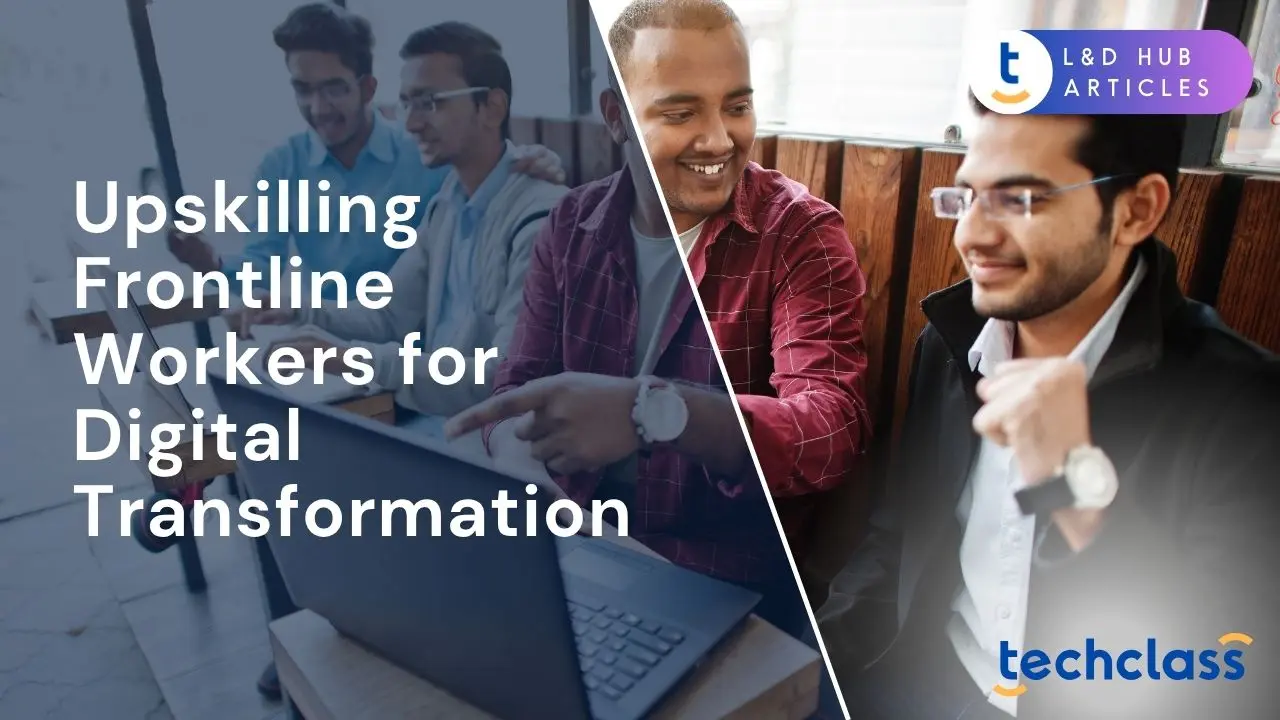
Walk into any store, warehouse, clinic, utility site, or factory floor and you will see where strategy turns into outcomes. Frontline employees are the face and hands of the business, which makes their skills a decisive factor in every transformation. Globally, roughly two to three billion people work without a traditional desk and must be physically present to do their jobs. That is as much as 70 to 80 percent of the world’s workforce, a reminder that digital change reaches far beyond corporate offices.
At the same time, the nature of work is shifting fast. Employers expect nearly half of workers’ core skills to change in the next few years and a clear majority of workers will need training to keep up. Analytical thinking, creative thinking, and technology literacy are climbing the skills agenda, alongside leadership and social influence. For HR leaders and enterprise executives, the implication is urgent and practical. Digital transformation will only scale if the people who run day to day operations build the right skills at the right pace.
Frontline roles are uniquely exposed to changing expectations. Customers want faster service, fewer errors, and more personalization. Equipment is smarter. Compliance standards are tighter. Yet most frontline workers say their current training does not fully prepare them to meet these demands.
Recent research across retail, hospitality, construction, manufacturing, and food service found that only about one quarter of frontline employees strongly agree they have the right amount and type of training to succeed. The same study shows that when frontline workers feel properly trained, they are clearer on performance expectations and much more likely to stay. In fact, workers who feel they have the training necessary to do the job are three times more likely to remain with their employer.
What gets in the way is rarely motivation. It is time, access, and practice. Four out of five frontline participants cited time and scheduling constraints, limited opportunities to practice new skills, and lack of resource access as the top barriers to development. That list will be familiar to any manager who has tried to pull people off the line for a classroom session during peak trading hours.
Finally, digital adoption lags on the front line. Many deskless workers still lack easy access to corporate systems and mobile devices, and enterprise tools are not always designed for the realities of shift work, mixed connectivity, or gloved hands. These gaps reduce productivity and make it harder to build new skills in the flow of work.
Upskilling frontline teams is not only a people priority. It drives hard results.
Productivity gains: When frontline workers receive a coherent package of digital tools and supportive processes, their productivity can rise by about 22 percent on average. That is the difference between meeting and missing daily production targets or delivering consistently on service promises.
Retention and internal mobility: Training that maps to real advancement opportunities anchors people to the organization. Walmart’s Live Better U program shows the impact at scale. The company reports hundreds of millions of dollars in tuition savings for associates and is now aligning short certificates to fill one hundred thousand in demand roles, including supervisory, supply chain, and select technology positions. At the same time, an external case study attributes four times lower attrition to participation in the program and double the likelihood of promotion.
Talent attraction and brand: Amazon’s Career Choice program has reached more than one hundred and ten thousand participants globally, with rapid growth after expanding prepaid education and coaching. For employers competing in tight labor markets, visible investments in learning can be the deciding factor for candidates choosing between similar roles.
Risk and quality: Equipped teams make fewer errors, resolve issues faster, and comply with evolving standards. That means fewer safety incidents, less rework, and a better customer experience. The bottom line contribution is significant once multiplied across thousands of transactions per day.
In short, frontline upskilling pays back through higher throughput, lower turnover, stronger engagement, and a more adaptable workforce. The returns amplify when training is integrated with better tools, clear career paths, and supervisor support.
The learning agenda varies by industry, but common clusters are emerging across sectors.
The World Economic Forum’s skills outlook offers a helpful compass. Analytical thinking, creative problem solving, and technology literacy are the most in demand and rising quickly, even in roles that were once entirely manual.
Frontline development succeeds when it starts from real work, not from catalogs.
Start with a role map and skills blueprint. Pick a few high volume roles that sit at the heart of the operation, such as store associate, picker and packer, field technician, or nurse assistant. Define the small set of capabilities that differentiate a novice from a reliable performer and from an expert. Use data to validate the list: safety incidents, defect rates, time to proficiency, customer satisfaction, or first time fix.
Solve the big three barriers. If time, practice, and access block learning, build the program so those constraints dissolve.
Design in the flow of work. Classroom sessions still have a place, but the heaviest lift should happen on the job through checklists, digital work instructions, and coaching prompts inside the tools people already use. This is how skill becomes habit.
Connect learning to advancement. Promise and proof go together. Publish the skills needed for higher paying roles and guarantee interviews for workers who demonstrate them. The strongest engagement effects appear when certificates or badges unlock real promotions or transfers, not just recognition. Walmart’s shift to short, job aligned certificates is instructive.
Co create with the front line. Include high performing associates and supervisors in content design and tool selection. They know the friction points, they can translate jargon into plain language, and they become champions during rollout.
Mobile microlearning. Fast modules on devices that employees already carry to work are the baseline. Prioritize content that can be completed in a few minutes between tasks and save longer lessons for scheduled learning time.
Guided digital work instructions. Step by step instructions with embedded media reduce errors and make cross training possible. For complex procedures, add checklists that require photo or sensor based verification.
Peer coaches and “train the trainer.” Supervisors and experienced associates are the most credible teachers. Provide them with structured practice guides and simple rubrics.
Simulations and VR where the risk or cost is high. Hazard recognition for drivers, patient safety drills, and advanced equipment procedures are good candidates for virtual practice that keeps people and assets safe. Use sparingly and measure impact.
Academic and credential partners. For career pathway skills, consider prepaid tuition and curated certificates with local colleges or online providers, backed by coaching. Walmart and Amazon demonstrate that this model scales when designed for working adults with clear job outcomes.
The mechanics of change look different on the floor than in an office.
Executives do not invest on faith. Build a measurement framework that connects skills to outcomes.
Define the north star metric per role. Examples include time to proficiency for new hires, first time fix rate for technicians, order accuracy in the warehouse, or customer satisfaction for store teams.
Track leading indicators. Skill assessments, on the job checklists, and supervisor observations give early signals that behavior is changing.
Tie to operational and financial results. When digital tools, process changes, and training roll out together, monitor throughput, scrap, rework, overtime, safety incidents, and returns. Quantify avoided costs and incremental revenue.
Monitor retention by participation. Programs that are tied to real career outcomes reduce churn. For example, a tuition free education benefit that is linked to internal hiring can meaningfully lower attrition and raise promotion rates among participants. Walmart’s program is a public case in point.
Value the digital experience. Since tool usability is correlated with productivity and engagement on the front line, include measures of digital friction or support tickets per worker, then connect these to the 22 percent productivity lift seen when the frontline digital experience improves.
Close the loop. Treat learning content like a product. Retire low impact modules, double down on high impact ones, and publish quarterly impact summaries so leaders see the business value.
Walmart: short certificates for in demand roles
Walmart’s Live Better U began as a low cost degree benefit and has evolved to emphasize short, job aligned certificates that map directly to roles the company wants to fill. Associates can complete many options in about four months and can translate Academy training into college credit. Walmart points to large tuition savings for associates and a plan to feed roughly one hundred thousand roles with internal talent. A separate case study credits participation with four times lower attrition and double the promotion rate. The lesson for other employers is to link education to internal career paths and measure outcomes beyond enrollments. (Walmart Corporate News and Information)
Amazon: prepaid education at global scale
Amazon’s Career Choice offers prepaid tuition, language learning, GED completion, and industry certifications through hundreds of education partners. After expanding benefits and coaching, the program reached more than one hundred and ten thousand participants and saw a surge in annual enrollments. Companies that want to emulate this model should prioritize prepaid options over reimbursement and include coaching so working adults can navigate choices efficiently.
Cross industry insight: the digital experience multiplier
Frontline teams are more productive, more engaged, and more likely to stay when the digital experience is designed for their realities. Evidence points to meaningful gains in output when workers receive the right mix of devices, apps, workflow support, and training that is integrated into those tools. Consider this a multiplier on your learning investment rather than a separate initiative.
Days 1 to 30: Baseline and focus
Days 31 to 60: Design and pilot build
Days 61 to 90: Pilot and measure
Digital transformation is not a software project. It lives or dies in the moments when a driver recognizes a hazard, a line operator adjusts a machine based on sensor data, or a store associate uses an app to solve a customer’s problem on the spot. Leaders who invest in frontline skills, align learning to real roles, and fix the digital experience where people actually work, convert strategy into reliable performance. The good news is that the playbook is clear and the outcomes are measurable. Start small, design with workers not just for them, and let business results keep score.
.webp)

